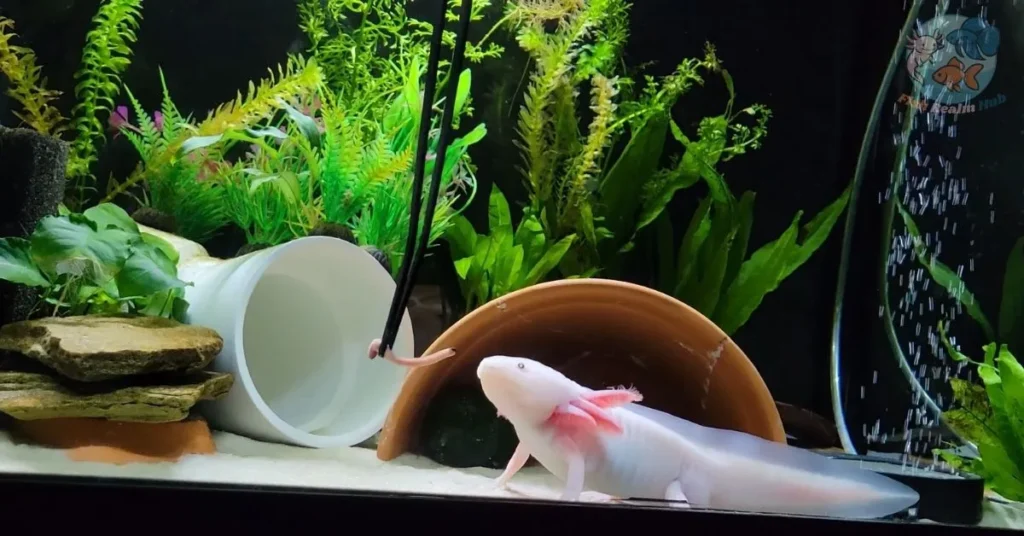When I first got my axolotl, I was super curious if he could eat some stuff from my kitchen—like tiny bits of chicken or eggs. I mean, it’s easy to think they might enjoy the same food we do, right? So one day, I gave him a tiny piece of plain boiled chicken (no salt or oil), and he actually ate it! But I didn’t make it a habit because I read later that too much human food can upset their stomach or mess with the water.
They’re not built like us, and their bellies are sensitive. What food is best for your axolotl really depends on what’s closest to their natural diet.

Now I only give human food as a rare treat, like a tiny bit of boiled egg white once in a while. I avoid anything spicy, salty, or with oil because it’s really bad for them. Honestly, I’ve learned that worms and pellets are just better for their health.
Oh, and by the way, I came across this weird question online—do people eat axolotls? Turns out, in some places they actually do, which I found kind of shocking. I mean, I couldn’t imagine eating mine. He’s more like a little water dragon to me than something you’d ever put on a plate!
Can Axolotls Eat Human Food?
I give him tiny pieces of boiled chicken or egg from my own food. It just seemed easier since I already had those things at home. I think a lot of people feel the same way—they want to share food with their pets or don’t always have special axolotl food around.
But the more I learned, the more I realized that axolotls have very different needs. Their bodies are made for eating things like earthworms, bloodworms, and pellets that are made just for them.
Human food might not hurt them right away, but it doesn’t give them the right stuff to grow and stay healthy. So now, I only feed him what’s best for him, even if I have to plan ahead a little.
Human Foods That Are Sometimes Safe for Axolotls
I searched if they were safe. That’s when I found out that a few human foods can be okay for axolotls, but only in small amounts and without any spices, oil, or salt. Still, I only use them when I have no other choice because their natural food is always the best.
I read in detail about a few types of human food that can sometimes be safe for axolotls
Cooked Plain Meat (In Moderation)
One time, I didn’t have worms or pellets for my axolotl, so I tried giving him a tiny piece of plain boiled chicken—no salt, no oil, nothing. I read that meats like chicken, turkey, or beef can be safe if they’re cooked the right way, but only in small amounts.
Too much can be hard on their stomach and isn’t really part of their natural diet. So now if I ever use meat, I give just a very small bite, and not often.
How much is too much?
Honestly, even a small piece can be enough. I usually keep it to a bite the size of his head or smaller, and I don’t give it more than once every few weeks. Too much meat, even if it’s plain, can mess up their digestion and cause health problems. It’s more like an emergency backup, not regular food.
Boiled Eggs (Only Egg White)
I once thought eggs would be a good soft food for my axolotl, but I found out raw eggs and yolk aren’t safe. The yolk is too fatty, and raw egg can carry bacteria. But boiled egg white is okay sometimes, because it’s soft and plain.
Just make sure it’s fully cooked and there’s nothing added to it.
How to prepare and serve safely
I boil the egg, peel it, and then carefully remove the white part. I cut a tiny piece, rinse it in water just to be safe, and offer it with tweezers. No seasoning, no salt, and always make sure it’s cool before giving it to my axolotl.
Plain Fish (Unseasoned, Deboned, Cooked or Frozen)
I also looked into fish like salmon or tilapia. Some axolotl keepers say it’s okay if it’s cooked or frozen and totally plain. But it has to be boneless and unseasoned. I tried a small bit of baked tilapia once—no oil, no spices—and my axolotl actually liked it. But just like meat and eggs, it’s not something I give often.
Avoiding oils and seasoning
The biggest thing I learned is that any kind of oil, salt, or spices can be dangerous for axolotls. Even if the food looks soft and clean, seasoning can harm them fast. So now I always double-check that anything I offer is completely plain and safe.
Human Foods That Should Be Avoided
At one point, I was tempted to share some of my own food with my axolotl, thinking a small bite wouldn’t hurt. But after doing some reading, I found out that spicy, salty, or seasoned foods can be really harmful.
Even a tiny piece can have additives that upset their system. These things might taste good to us, but for axolotls, they can damage their gut and liver, which are super sensitive.
I also found out that dairy products are a complete no-go. Since axolotls can’t handle lactose, anything like cheese or milk can mess with their digestion. Their body just isn’t made to break down dairy, so it’s safer to avoid it altogether—even a small drop can cause trouble.
At first, fruits and veggies seemed harmless, but I learned that axolotls can’t digest plant matter properly. Their body is built for a meaty diet, not plants. Feeding them fruits or vegetables can cause bloating or even impaction, which can be serious. So now, I stay away from all human food unless I know it’s 100% safe—and most of the time, it’s not worth the risk.
Risks of Feeding Human Food to Axolotls
One time, I was eating dinner and started wondering if my axolotl could try a bite of what I had. It felt harmless at first—just a soft bit of egg—but later I noticed he wasn’t acting normal.
Turns out, their bodies are super sensitive, and even small amounts of human food can lead to digestive problems like bloating or refusal to eat.
Risks of Feeding Human Food to Axolotls don’t stop there. I also learned that leftover bits in the tank can cause water contamination, which makes the water dirty and unsafe fast. On top of that, feeding them the wrong stuff can mess with their behavior.
My axolotl got sluggish and less active. Since then, I’ve stuck to safe food only. If you’re curious about what else they might eat, check this out: will axolotls eat fish.
Safer Alternatives to Human Food
At first, I really wanted to give my axolotl something from my kitchen, but I later found out it’s much safer to stick with foods made just for them. One of the best things I discovered was live food—earthworms, blackworms, and daphnia. My axolotl absolutely loves nightcrawlers, and they’re actually super healthy for him. I usually cut them into small pieces and feed them based on a proper axolotl feeding schedule, so he doesn’t get too much or too little.
Safer Alternatives to Human Food also include frozen options like bloodworms and brine shrimp, which are great when you don’t have live food around. I just thaw a small portion and make sure it’s clean before feeding. For daily meals, I keep a container of high-quality axolotl pellets. They’re easy to store and help make sure my axolotl is getting the nutrients he needs. Ever since I switched to these safer options, he’s been way more active and looks healthier too.
Expert Tips on Feeding Axolotls Properly
When I started learning about the axolotl diet, I didn’t realize how important the right portion size was. I used to feed random amounts, but then I noticed my axolotl was getting bloated and leaving food behind.
Now, I only give food that’s about the size of his head, and I feed him every two to three days. That small change made a big difference in how active and healthy he looks.
One thing I always do now is remove any uneaten food after about 15 minutes. If it sits too long, it can mess up the water and stress him out. Also, when I try something new—like a different type of worm or pellet—I always test with a tiny bit first and watch how he reacts.
Some things just don’t work for every axolotl, so it’s safer to go slow and see what they like without risking their health.
Final Thoughts: Should You Feed Human Food to Axolotls?
After everything I’ve learned, I think it’s just better to avoid giving your axolotl human food. Some stuff might seem harmless—like plain chicken or egg—but it’s really not made for their body. It can cause stomach problems or mess up the water.
So yeah, most human foods are unsafe, and only a few might be okay, but even then, it’s risky and not really worth it.
If you ever feel like trying something new, make sure it’s safe, and give only a tiny piece. But honestly, I’ve had the best results just sticking with foods made for axolotls, like worms and pellets. It keeps things simple and safe.
At the end of the day, their health matters more, and a proper axolotl-specific diet is the best way to keep them happy and active.
FAQs
What household foods can axolotls eat?
Some people wonder if axolotls can eat things from the kitchen, and while a few options are okay, it’s important to be careful. Things like narrow strips of raw lean beef, bits of plain chicken, or even soft fish might seem safe, but they should only be offered rarely and in very small amounts. These should be fed by hand, slowly wiggling the food in the water to get the axolotl’s attention. Still, it’s better to stick with their usual diet—earthworms, insects, small crustaceans, and pelleted food made for carnivorous fish, like salmon pellets, which are made to meet their needs better.
What will make my axolotl happy?
To keep my axolotl happy, I learned that good care is more than just food. Along with avoiding most human food, I make sure to feed him live food for optimal nutrition, and I also provide small hides where he can rest in comfort. I use a sponge filter and air stone to keep the oxygen levels high, and a thermometer helps me monitor the tank temperature. A light with programmable lighting keeps the day-night cycles natural. I also found out it’s best to separate them if there’s any aggression, especially during feeding time.
What is axolotl’s favorite food?
While many people wonder what human food axolotls can safely eat, it’s clear that axolotls have their own favorites when it comes to proper food. Nearly all of them love bloodworms and brine shrimp, but some might prefer one food item over another. Watching my axolotl choose between the two was interesting—he grabbed the bloodworms first, even when both were offered. Each axolotl has its own taste, but those two options always seem to excite them the most.
Can axolotls eat bread?
Some people might think bread sounds like a harmless food for axolotls, but it’s not a good idea. Even though it has nutrients like carbohydrates and protein, and has that soft airiness and moistness from yeast and sugar, it’s not made for them. I once let mine consume a tiny piece during a meal, but he seemed a bit off afterward. Their bodies aren’t built to handle what’s in bread, so even if they can nibble it, it doesn’t mean it’s safe or healthy.

